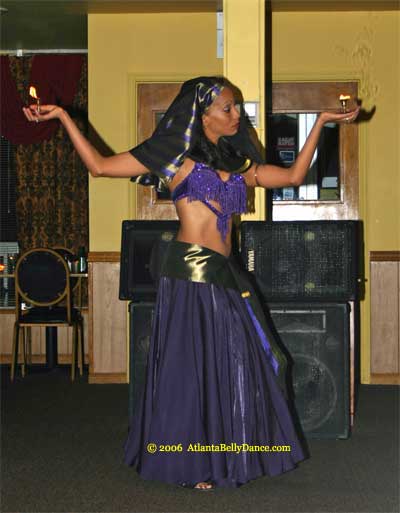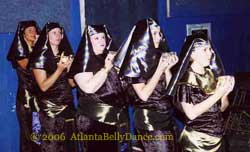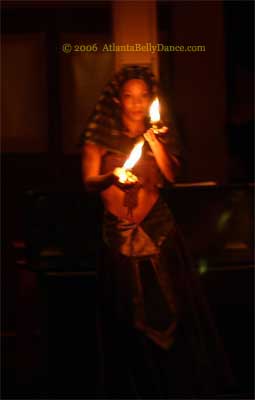
|

|
|||||||
A DefinitionTechnically, the name Pharaonic dance refers to "dance style performed in the time of the Egyptian pharaohs". When most dancers use the term, they are associating it with modern day beliefs about the culture of ancient Egypt, many of which have not been supported by research. In other words, most such performances are a 20th-century or 21st-century creation which grew out of the Orientalist art and literature movement of the 19th century and the early days of the modern dance movement.Usually, Pharaonic dance is performed to New Age music, by a dancer or ensemble wearing clothing inspired by the paintings from tomb walls. Many such dances will include poses with the palms of the hands flat and parallel to the floor, sometimes with candles balanced on them. Such poses aren't supported by historical research, but because Western audiences have been conditioned by the posturing of early modern dance artists to expect these poses in Pharaonic dance, performers often include them to lead the audience into the right frame of mind. Of course, the major problem with this approach is that it's a cliché. People do it because it's easy, but that doesn't mean it's the path to a captivating performance. That's why some people who refer to their dance as "Pharaonic" take a different approach, and what they create may look entirely different from the above. These dancers have done their own independent research into examining artwork from ancient Egyptian sources. They have attempted to extrapolate what types of movement may have been depicted by such pictures. These dancers have provided the most exciting interpretations what the dance forms of ancient Egypt may have looked like. CostumingSome dancers wear fairly simple costuming for Pharaonic dance, teaming a simple white robe with a Cleopatra-style wig and a gold band around the forehead. Others create beautifully draped elaborate dresses with sumptuous jewelry, belts, and other accessories.The abundant supply of Egyptian artwork that has been discovered on tomb walls provides many costume ideas. Spend some time studying books about the art and history of ancient Egypt to look for ideas that appeal to you. 
MusicFor music, we know from ancient artwork that they used harps, flutes, stringed instruments that resemble the modern-day saz (long-necked lute), frame drums, and sistrums (type of rattle). Some of the illustrations in Ancient Egyptian Dances distort the shape of the fingers, as if they were playing finger cymbals or castanets. This allows us to make some guesses about the type of music that may have been used.One suitable music for this is "Ancient Egypt", composed in 1978 by Ali Jihad Racy, an Egyptian ethnomusicologist for the King Tutankhamun Exhibit in Seattle. Racy has conducted extensive research into musical notations and instrumentation from ancient times and composed some fascinating music based on what he learned. It's probably the closest you're likely to get to music that captures the true flavor of ancient Egypt, short of finding an ancient CD in an as-yet undiscovered tomb. Many dancers choose New Age music for their Pharaonic interpretations, particularly if they choose to enact a temple scene. The band named Desert Wind has a number of CD's that may provide inspiration. My favorite Desert Wind CD's are Kali Ma and Return to the Goddess. Volume 6 of the Eddie Kochak "Strictly Belly Dancing" recordings contains one song titled Phaedra Pharaonica which is intended for this type of dance interpretation. MovementDon't limit yourself to those funny arm and hand poses that everyone thinks are typically Egyptian. If you want to throw some of these poses in because it matches your creative vision, that's your privilege as an artist. But don't feel that you're required to. Try to expand your thinking beyond the obvious cliché, and unleash your personal creativity.Start with a view of what message you want the dance to portray. Then pick music that evokes that message in you. Once you have your message and your music, the movements will follow. Just make sure that your movements and your desired costuming approach will work together!
Who Teaches Pharonic Dance?There aren't many belly dancers who teach or perform Pharaonic dance because it's not part of the mainstream. For that reason, you'll probably have difficulty finding a teacher in your community who has worked with Pharaonic dance. You may need to rely on videos showing performance of Pharaonic dance as a source of ideas and inspiration.We (Nazeem Allayl) do regularly teach a pharonic dance as a beginner level dance. Another instructor in America, Daliah, also teaches some versions of a Pharonic dance. 
Daliah writes: (www.visionarydance. com/experienceBeau.html) The next series of movements is symbolic of a loosening of the branches. With focused emotional intensity, the hand turns down the center column of the body in front of the face, throat and to the heart where it unfolds out to the left. The motion returns along the same path and then repeats on the right. Both arms return overhead. The dancer looks up at her hands as they open and move forward and appear as if they hold a heavy globe. I call this move “drawing down the moon”. Within open time in the music, the image is the qua for the dancer now, rather than a counted choreography. “Visualize! Imagine you are magically pulling down the moon and dropping it into a pool of water at your feet,” I tell my students. As they do this they descend to the ground on bent knee. I call this the sandal pose. I instruct them to lose themselves in the inspiration of the moon’s reflection on the water and improvise a floor dance to the rest of the musical passage. In this dance we go from left-brain directed choreography to right-brain personal investment. But that is not all. We go from standing in airspace and working the entire body in forms and dimensions, to recognizing the heavens, connecting with the heart, to the sanctity of the earth and the soul’s ground. People have been coming down to the earth to pray since the beginning. This is no accident. There is powerful soul work to be done here. This is a sacred dance. One of the most important aspect about dance is this: the openness and freedom of the second section of this dance expands the idea of dance as performance to dance as personal ritual or public worship, which would put it into the category of liturgical dance. In the space left open in this dance, I have sung songs, and read poems. I have voiced or silently made prayers. I have made wishes and spoke positive affirmations for myself. I have simply listened, being sure to breathe and be present and then let the spirit guide me as to where to move as a dancing sculpture unfolds from within my bones - an original dance.
Sources:
|

